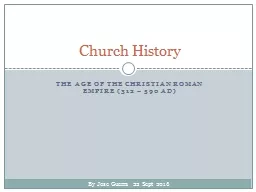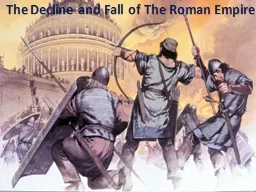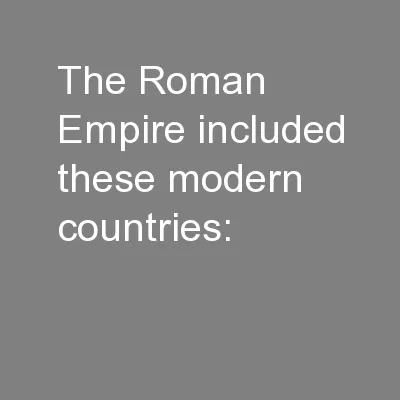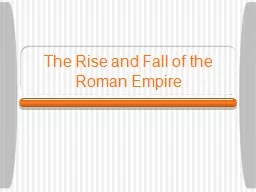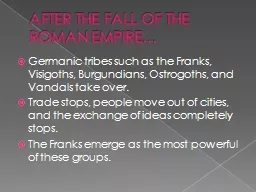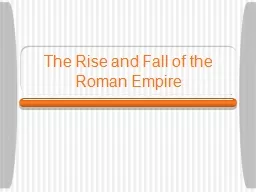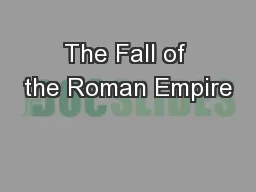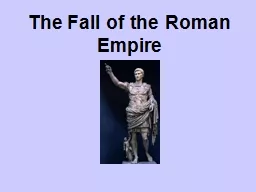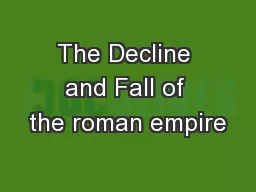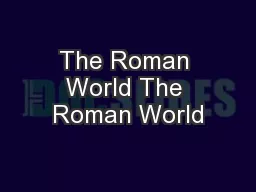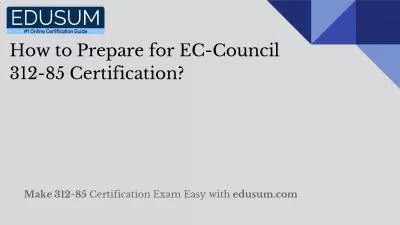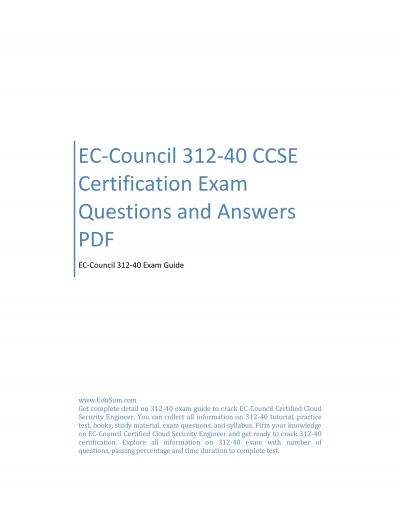PPT-The Age of the Christian roman empire (312 – 590 ad)
Author : pasty-toler | Published Date : 2017-11-29
Church History By Jose Guerra 22 Sept 2016 Primary Source Material Agenda Hand out outlines Define the lesson timeline for the session Review Resource page on
Presentation Embed Code
Download Presentation
Download Presentation The PPT/PDF document "The Age of the Christian roman empire (3..." is the property of its rightful owner. Permission is granted to download and print the materials on this website for personal, non-commercial use only, and to display it on your personal computer provided you do not modify the materials and that you retain all copyright notices contained in the materials. By downloading content from our website, you accept the terms of this agreement.
The Age of the Christian roman empire (312 – 590 ad): Transcript
Church History By Jose Guerra 22 Sept 2016 Primary Source Material Agenda Hand out outlines Define the lesson timeline for the session Review Resource page on EHBC website The Age of the Christian Roman Empire. Theories behind the shrink . by the 300s “barbarian” groups like the Goths had encroached beyond the Empire’s . borders. 410 the Visigoth King Alaric successfully sacked the city of . Rome. The . Preview of . This Weeks. Lessons. A. What were the main problems facing Rome after the . Pax. . Romana. ?. B. What reforms did Emperors . Diocletian. and . Constantine. make to address these problems? Were they successful? . Portugal. Spain. Andorra. United Kingdom. France. Monaco. Luxembourg. Belgium. Netherlands. Germany. Switzerland. Liechtenstein. Italy. San Marino. Vatican City. Malta. Austria. Czech Republic. Slovakia. Rome built great stuff. Rome built great roads to travel on and aqueducts to bring water into the city.. Rome also built great stadiums and amphitheaters for the entertainment of the people.. Romans also developed the use of the arch. . Germanic tribes such as the Franks, Visigoths, . Burgundians. , . Ostrogoths. , and Vandals take over.. Trade stops, people move out of cities, and the exchange of ideas completely stops.. The Franks emerge as the most powerful of these groups.. Rome built great stuff. Rome built great roads to travel on and aqueducts to bring water into the city.. Rome also built great stadiums and amphitheaters for the entertainment of the people.. Romans also developed the use of the arch. . Instructions. Get out a blank piece of paper. Write “Downfall of Rome” on the top of your paper. Write the title for each slide on your paper. Skip a line, indent and write only the words in . red. The Roman Empire at its Height. The Roman Empire became huge. It covered most of Europe, North Africa, and some of Asia. The Empire reached its height under Emperor Diocletian (284-305 CE). Expansion: Good or Bad?. Chapter 11, Section 3. THE BEGINNING OF THE END:. THE DECLINE. The . Pax. . romana. Translated means “Roman Peace”. Began with the reign of Augustus and ended with the death of Marcus Aurelius. Rome . CHAPTER 7. Augustus . Primaporta. ,. Pax. . Romana. (Roman. 3. 4. Establishment of Rome. Legend of Romulus and Remus. Rome Founded 753 BCE. Indo-European migrants c. 2000 BCE. Bronze c. 1800 BCE, Iron c. 900 BCE. Start Here--- http://bit.ly/3X5QvRy ---Get complete detail on 312-85 exam guide to crack EC-Council Certified Threat Intelligence Analyst. You can collect all information on 312-85 tutorial, practice test, books, study material, exam questions, and syllabus. Firm your knowledge on EC-Council Certified Threat Intelligence Analyst and get ready to crack 312-85 certification. Explore all information on 312-85 exam with number of questions, passing percentage and time duration to complete test. Start here---http://bit.ly/3lTNTIX---Get complete detail on 312-76 exam guide to crack v3. You can collect all information on 312-76 tutorial, practice test, books, study material, exam questions, and syllabus. Firm your knowledge on v3 and get ready to crack 312-76 certification. Explore all information on 312-76 exam with number of questions, passing percentage and time duration to complete test. Start here---http://bit.ly/3lTNTIX---Get complete detail on 312-76 exam guide to crack v3. You can collect all information on 312-76 tutorial, practice test, books, study material, exam questions, and syllabus. Firm your knowledge on v3 and get ready to crack 312-76 certification. Explore all information on 312-76 exam with number of questions, passing percentage and time duration to complete test. Get complete detail on 312-40 exam guide to crack EC-Council Certified Cloud Security Engineer. You can collect all information on 312-40 tutorial, practice test, books, study material, exam questions, and syllabus. Firm your knowledge on EC-Council Certified Cloud Security Engineer and get ready to crack 312-40 certification. Explore all information on 312-40 exam with number of questions, passing percentage and time duration to complete test.
Download Document
Here is the link to download the presentation.
"The Age of the Christian roman empire (312 – 590 ad)"The content belongs to its owner. You may download and print it for personal use, without modification, and keep all copyright notices. By downloading, you agree to these terms.
Related Documents

